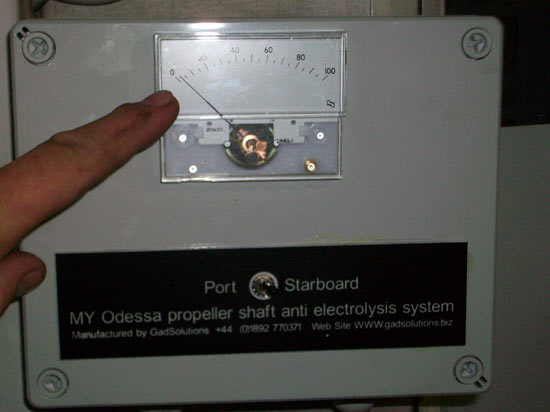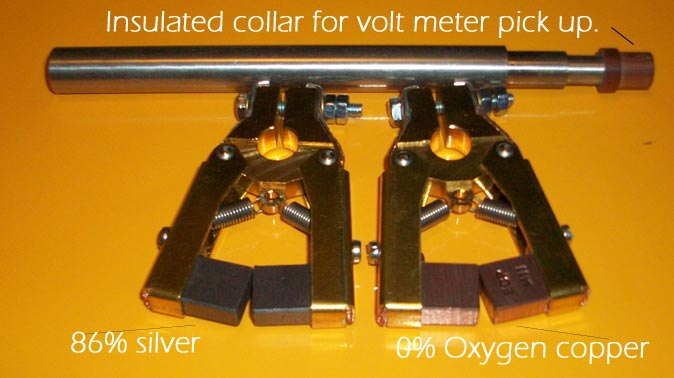GadSolutions manufactures slip rings for propeller shafts to combat the electrolysis action of a spinning shaft (steel) within bearings (usually bronze/white metal, ball bearings for motors) immersed in sea water (electrolyte).
Various combinations of slip-ring and carbon brush materials are available but time has determined that only high silver composition brushes running on a silver track or 0% Oxygen Copper, can provide the effective and sustained low conductivity necessary to ensure that the shaft bonding and its connections maintains a contact resistance no greater than 0.001 Ohms.
Current passing through the gearbox bearings can severely damage them see Bearing degradation through electric current
At 59.6×106 S/m copper has the second highest electrical conductivity of any element, just after silver. This high value is due to virtually all the valence electrons (one per atom) taking part in conduction. The resulting free electrons in the copper amount to a huge charge density of 13.6×109 C/m3. This high charge density is responsible for the rather slow drift velocity of currents in copper cable (drift velocity may be calculated as the ratio of current density to charge density). For instance, at a current density of 5×106 A/m2 (typically, the maximum current density present in household wiring and grid distribution) the drift velocity is just a little over ⅓ mm/s.
 In practice very few ships engineers have ohm meters capable of reading such low values and it is therefore difficult to determine the conductivity of the system. If GadSolutions install the system we use our calibrated low ohm reading test meter to insure a sound electrical connection with all parts of the system. A voltmeter with a range of 75 Millivolt F.S.D is installed to constantly monitor the connections and ensure the level of potential difference between shafts and hull is kept below 50 Millivolt (believed to be the minimum at which electrolysis starts) in practice we usually achieve 3 Millivolt PD.
In practice very few ships engineers have ohm meters capable of reading such low values and it is therefore difficult to determine the conductivity of the system. If GadSolutions install the system we use our calibrated low ohm reading test meter to insure a sound electrical connection with all parts of the system. A voltmeter with a range of 75 Millivolt F.S.D is installed to constantly monitor the connections and ensure the level of potential difference between shafts and hull is kept below 50 Millivolt (believed to be the minimum at which electrolysis starts) in practice we usually achieve 3 Millivolt PD.
The system of shaft bonding comprises a split slip-ring arrangement and ancillary brush gear, which is designed to facilitate ease of assembly by proficient technical personnel and without the need for specialist tools. We hone each slip-ring to ensure a precise fit and constant contact with the propeller shaft, coupled with the 4 grub screws that drill into the shaft ensuring a very good electrical connection.
The monitoring panel shows a working installation of the slip-rings, 1 millivolt was shown as the potential difference between propellers ,shafts and the hull. With such a low reading no electrolysis will take place.



Since you supplied and fitted our slip rings the vessel has done two seasons of chartering in both the Caribbean and the Med with no trace of corrosion. Thanks very much for your expertise.
We have a Diesel electric powered Yacht of 98 Mtrs.We often found pitting in the propellers and the bearings of the electric motors (4Kv) did not last as they should. After fitting the slip rings you supplied for us (Oct 2009) there have been no more bearing failures and the propellers are not showing signs of corrosion. I am not allowed to name the yacht but most people in the Yacht chartering business will know who we are. Thanks for your services. We are very pleased to recommend your slip rings.